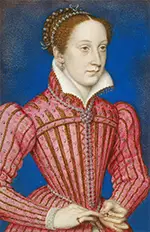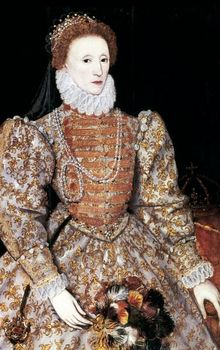Mary, Queen of Scots
Part 2: Shattered Dreams Mary, Queen of Scots had her own claim of legitimacy to the English throne, through her grandmother, Margaret Tudor. She was the sister of Henry VIII and had married Scotland's King James IV and had served as regent for her infant son, James V. France's King Henry II proclaimed his daughter-in-law Queen of England and his son a king consort. Elizabeth took little notice of the fact. Henry II died in 1559, and his son became King Francis II. Mary was then queen of France. Francis died the very next year, and Mary returned to Scotland. She formed a privy council that included her half-brother, the Earl of Moray, a Protestant leader. Mary also sent an ambassador to the English court to make her case as a successor to Elizabeth. That queen refused to name Mary or anyone else as her successor. 
Mary married again in 1565, to Henry Stuart, Lord Darnley, who was her half-cousin, himself a grandchild of Margaret Tudor. Also in that year, the Earl of Moray gathered a number of troops and declared himself in rebellion against the queen. Mary raised a force sympathetic to her, and the two sides opposed each other for a time. Moray eventually fled the country, and both sides put down their arms. Darnley decided that he wasn't content to be the queen's consort but wanted to have status equal with her, so that he could become king if she died. Mary refused. Her husband temporarily joined up with Moray's forces who were looking for another fight, and one of their victims was Mary's private secretary, who they killed at a dinner party that Mary had thrown. Darnley tamed his ambitions, and Mary forgave him, but the couple fell on hard times again. They had become parents in the meantime, however. Their son James was born on June 19, 1566, in Edinburgh Castle. The following year, Darnley died a suspicious death. Mary next turned to an English noble, James Hepburn, the Earl of Bothwell, as a husband. They were married in May 1567 at Holyrood Castle. A group of nobles who had at first supported the marriage then turned against the queen and her new husband. Another armed conflict ensued, and Mary decided to turn herself over to the rebel troops to save her husband and her young son. She was held prisoner in Lochleven Castle and forced to sign a document of abdication. King James VI was crowned in July 1567. 
Mary escaped her confinement and gathered another armed force, to try to win back her throne. Her supporters were defeated again, and Mary fled to England. Elizabeth welcomed Mary at first but eventually put her under house arrest because of real or perceived threats to Elizabeth from the many Catholics who wanted someone else on the throne.  Elizabeth kept Mary imprisoned for the next 19 years, moving her from castle to castle. She lived in relative comfort, with her own staff and belongings, but she was still under house arrest. A number of high-profile people were involved in plots to assassinate Elizabeth and replace her with Mary. How much of all of this Mary herself knew about is still being debated by historians. She was certainly under surveillance for most if not all of her time as Elizabeth's "guest." Mary herself proposed to renounce all claims to the English Crown and to agree to sanction any marriage that her son wished to make, provided that Elizabeth agreed; after initially approving of the idea, James changed his mind and made an alliance with Elizabeth.  In 1586, Elizabeth was presented with evidence of a plot by Mary to kill the English queen and seize the throne. Among the evidence were coded letters written and received by Mary. One of the people to whom she wrote was Anthony Babington, who wanted to see Elizabeth killed and a Catholic on the English throne. This became known as the Babington Plot. The letters clearly showed that Mary was conspiring to kill Elizabeth and profit at her expense. The English Crown put Mary on trial for treason. The trial lasted just two days, ending on Oct. 16, 1586 with a verdict of guilty and a sentence of death. Mary, who had acted in her own defense and had fervently denied all charges, was executed on Feb. 8, 1587, at Fotheringhay Castle. The gap between the verdict and the execution was so wide because Elizabeth worried about setting a precedent by ordering the death of a fellow sovereign. First page > Scotland, France, and England > Page 1, |
|
Social Studies for Kids
copyright 2002–2024
David White




